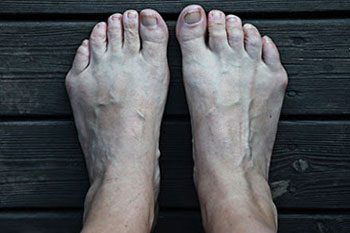
Learn What Causes Bunions
A tailor’s bunion or bunionette is a bony lump that forms when the fifth metatarsal bone shifts outwards along the side of your little tow. A bunion can be really painful, especially if it rubs against your shoe or slides. A tailor’s bunion is more or less like a regular bunion, however, it grows in a different location.
Bunions are usually genetic, occurring as a result of a faulty foot structure. Some inherited conditions contribute to the formation of bunions on feet including, abnormal bone structure, flat feet, and excessively flexible ligaments. According to a few experts, shoes that don’t fit properly can cause bunions while others think they only worsen an existing problem!
Unlike the typical ones that form inside the big toe’s base, a tailor’s bunion grows outside the little toe’s base. Yet, it is quite rare to get a tailor’s bunions compared to regular bunions. Still, if you are in that 4% of the population suffering from a tailor’s bunions on feet, we can help you out!
How to Get Rid Of Bunions
Surgery, known as osteotomy, is the only way to get completely rid of bunions. Yet, we know how to shrink and manage bunions naturally to stop bunion formation from getting any worse.
8 Tips: How to shrink bunions naturally
Wear the right shoe size
Buy shoes that aren’t too tight and have a wider toe area with heels less than one to two inches long. Make sure it also provides good support for your foot arch. You can even ask the salesperson to suggest shoes that measure perfectly with the width and length of your foot.
Ice your foot/ affected area
Ice pack helps to reduce inflammation and swelling on a sore bunion, gradually shrinking the bunions naturally.
Size shoes by comfort, not number
Different companies slightly have variations in their shoe sizes, design, and structure. Before finalizing your purchase, take a short walk around the store to measure comfort instead of simply picking your regular foot size.
Avoid wearing flip-flops
Shoes or flip-flops that don’t provide arch support add extra pressure on your big toe’s joint. Therefore, try to avoid such styles while dealing with bunions.
Use inserts in your shoes
To add arch support and rectify proper foot alignment, use inserts in your shoes. You can find those from your nearest drug store, often prescript by orthotics as well.
Space your toes out
Reduce pressure on your toes using toe spacers at night or while wearing shoes that add a gap between your toes.
Add relief with warm water
Soak your feet in the perfect combination of warm water and Epsom salt to reduce inflammation and soothe them.
What does a bunion look like?
A bunion looks like a bump growing on either a big toe or a small one. As a result, of your foot abnormality, a bump forms, causing your one toe to lean towards the second one instead of being straight. The reason might vary, but this change in angle produces a visible bump on your toe.
In a few cases, the bump doesn’t hurt at all. The bunion starts to crowd the toes together, causing pain and even permanent deformity as time goes by.
Bottom Line
With many surgical and natural treatments to manage your bunion, you can contact your doctor if your bunion makes it difficult to wear shoes on. Avoid further worsening of a bunion by wearing shoes that fit properly. The perfect shoe size helps get enough space to conform around that retains back your foot shape.
If you are dealing with a painful condition that you believe might be a bunionette, make an appointment with a podiatrist for an examination and to discuss your treatment options.
